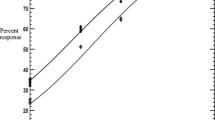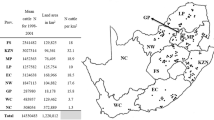Abstract
Traditional systems account for 95 % of the livestock produced in Burkina Faso. Tick infestation hampers livestock productivity in this area. However, little information exists on tick-control practices used by livestock farmers. We interviewed 60 stockbreeders working in traditional farming systems to obtain the first data on tick-control practices. Sixteen farmers (27 %) did not use conventional practices: seven removed ticks by hand or plastered cattle with dung or engine oil; nine farmers treated cattle with crop pesticides. Forty-four farmers (73 %) used mainly synthetic pyrethroids (SP; either alphacypermethrin or deltamethrin in 20 and 18 farms, respectively) and occasionally amitraz (N = 6). Intervals between treatments varied significantly depending on the chemical used: most farmers using crop pesticides (100 %), amitraz (100 %) or alphacypermethrin (80 %) adjusted tick-control to tick-burden, whereas farmers using deltamethrin tended more to follow a tick-control schedule. Perception of tick-control effectiveness significantly varied among practices: tick-control failures were more frequently reported by farmers using alphacypermethrin (55 %) than by those using either other conventional acaricides (17 %) or crop pesticides (0 %). We investigated whether this could indicate actual development of SP-resistance in cattle ticks. First, using the larval packet test technique, we confirmed that the computation of LC50 and LC90 was repeatable and remained stable across generations of the Rhipicephalus (Boophilus) geigyi Houndé laboratory strain. We then collected from the field fully-engorged female R. geigyi to evaluate the SP-resistance relative to the Houndé reference strain. We did not detect any case of SP-resistance in the field-derived R. geigyi ticks.

Similar content being viewed by others
References
Akinboade OA, Dipeolu OO (1981) Detection of Babesia bovis infections in Boophilus geigyi with egg crushings, larval smears, and haemolymph puncture. Vet Q 3(3):143–147
Anonymous (2003) Rapport National sur l’état des ressources génétiques animales au Burkina Faso. Ministère des Ressources Animales, Ouagadougou
Anonymous (2004) Enquête Nationale sur les effectifs du cheptel. Ministère des Ressources Animales et Ministère de l’Economie et du Développement, Ouagadougou
Farougou S, Kpodekon M, Adakal H, Sagbo P, Boko C (2007) Abondance saisonnière des tiques (Acari : Ixodidae) parasites des ovins dans la région méridionale du Bénin. Rev Méd Vét 158:627–632
Food Agriculture Organization of the United Nations, FAO (2004) Guidelines resistance management and integrated control in ruminants. Animal Production and Health Division, Agriculture Department. FAO, Rome, pp 25–77
Jongejan F, Uilenberg G (1994) Ticks and control methods. Rev Sci Tech Off Int Epizoot 13:1201–1226
Knopf L, Komoin-Oka C, Betschart B, Jongejan F, Gottstein B, Zinsstag J (2002) Seasonal epidemiology of ticks and aspects of cowdriosis in N’Dama village cattle in the Central Guinea savannah of Côte d’Ivoire. Prev Vet Med 53:21–30
LeOraSoftware (1987) A user’s guide to probit or logit analysis. LeOra Software, Berkeley
Madder M, Thys E, Geysen D, Baudoux C, Horak I (2007) Boophilus microplus ticks found in West Africa. Exp Appl Acarol 43:233–234
Madder M, Thys E, Achi L, Touré A, De Deken R (2011) Rhipicephalus (Boophilus) microplus: a most successful invasive tick species in West Africa. Exp Appl Acarol 53:139–145
Madder M, Adehan S, De Deken R, Adehan R, Lokossou R (2012) New foci of Rhipicephalus microplus in West Africa. Exp Appl Acarol 56:385–390
Mattioli RC, Janneh L, Corr N, Faye JA, Pandey VS, Verhulst A (1997) Seasonal prevalence of ticks and tick-transmitted haemoparasites in traditionally managed N’Dama cattle with reference to strategic tick control in the Gambia. Med Vet Entomol 11:342–348
Moreira C, Schiffers B, Haubruge E (2002) Caractérisation de la résistance au Sénégal d’Helicoverpa armigera HUBNER (Lépidoptère, Noctuidae) par bioessai et méthodes moléculaires. Parasitica 58:89–98
Nianogo AJ, Somda J (1999) Diversification et intégration inter-spécifique dans les élevages ruraux au Burkina Faso. Biotechnol Agron Soc Environ 3:133–139
Pegram RG, Oosterwijk GPM (1990) The effect of Amblyomma variegatum on liveweight gain of cattle in Zambia. Med Vet Entomol 4:327–330
Pegram RG, Lemche J, Chizyuka HGB, Sutherst RW, Floyd RB, McCosker PJ (1989) Effect of tick control on liveweight gain of cattle in central Zambia. Med Vet Entomol 3:313–320
Plowright (1956) Cutaneous streptothricosis of cattle: I. Introduction and epizootiologivcal features in Nigeria. Vet Rec 68:350–355
Robertson JL, Preisler HK (1992) Pesticides bioassays with arthropods. CRC, Boca Raton 127 pp
Stachurski F (2000) Modalités de la rencontre entre la stase adulte de la tique Amblyomma variegatum (Acari, Ixodida) et les bovins: applications potentielles à la lutte contre ce parasite. Université de Montpellier II (Sciences et Techniques du Languedoc), Montpellier, Thèse de Doctorat ès Sciences
Stachurski F, Musonge EN, Achukwi MD, Saliki JT (1993) Impact of natural infestation of Amblyomma variegatum on the liveweight gain of male Gudali cattle in Adamawa (Cameroon). Vet Parasitol 49:299–311
Stone BF, Haydock KP (1962) A method for measuring the acaricide susceptibility of the cattle tick Boophilus microplus (Can.). Bull Entomol Res 53:563–578
Sutherst RW, Kerr JD (1987) Losses in livestock productivity caused by ticks and tick-borne diseases. In: Proceedings of an international workshop on the ecology of ticks and epidemiology of tick-borne diseases, pp 108–l12
Walker AR, Bouattour A, Camicas JL, Estrada-Peña A, Horak IG, Latif AA, Pegram RG, Preston PM (2003) Ticks of domestic animals in Africa. A guide to identification of species. Bioscience Reports, Scotland
Acknowledgments
Funding for this work was provided by the French Government through the Fonds de Solidarité Prioritaire (FSP) under contract no 2000-113. We thank the Burkina Faso Veterinary Services for tick collection assistance, Sébastien Zoungrana and Maurice Konkobo for laboratory assistance. Special thanks to Dr. Lesley Bell-Sakyi, Dr. Peter Willadsen and Dr. Maxime Madder for their valuable and useful comments on the manuscript.
Author information
Authors and Affiliations
Corresponding author
Rights and permissions
About this article
Cite this article
Adakal, H., Stachurski, F. & Chevillon, C. Tick control practices in Burkina Faso and acaricide resistance survey in Rhipicephalus (Boophilus) geigyi (Acari: Ixodidae). Exp Appl Acarol 59, 483–491 (2013). https://doi.org/10.1007/s10493-012-9610-5
Received:
Accepted:
Published:
Issue Date:
DOI: https://doi.org/10.1007/s10493-012-9610-5




